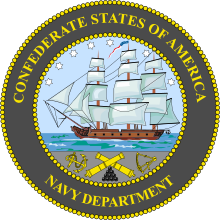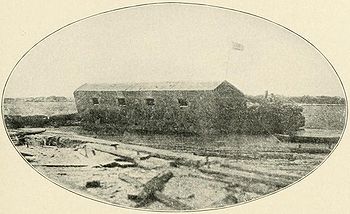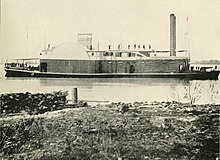
The Confederate States Navy (CSN) was the naval branch of the Confederate States Armed Forces, established by an act of the Confederate States Congress on February 21, 1861. It was responsible for Confederate naval operations during the American Civil War against the United States's Union Navy.
USS New London was a screw steamer of the Union Navy during the American Civil War. She was outfitted with a Parrott rifle and 32-pounders, and was assigned as a gunboat in the Union blockade of the Confederate States of America.

CSS Tennessee was a casemate ironclad ram built for the Confederate Navy during the American Civil War. She served as the flagship of Admiral Franklin Buchanan, commander of the Mobile Squadron, after her commissioning. She was captured in 1864 by the Union Navy during the Battle of Mobile Bay and then participated in the Union's subsequent Siege of Fort Morgan. Tennessee was decommissioned after the war and sold in 1867 for scrap.

USS Merrimack, also improperly Merrimac, was a steam frigate, best known as the hull upon which the ironclad warship CSS Virginia was constructed during the American Civil War. The CSS Virginia then took part in the Battle of Hampton Roads in the first engagement between ironclad warships.

CSS Florida was a sloop-of-war in the service of the Confederate States Navy. She served as a commerce raider during the American Civil War before being sunk in 1864.
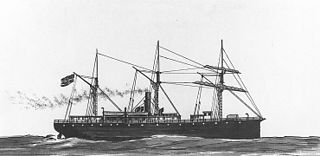
The third USS Montgomery was a wooden screw steamer in the Union Navy during the American Civil War.

The first USS Seminole was a steam sloop-of-war in the United States Navy during the American Civil War.

USSWhitehead, a screw steamer built in 1861 at New Brunswick, New Jersey, served as a gunboat in the United States Navy during the American Civil War.

The second USS Memphis was a 7-gun screw steamer, built by William Denny and Brothers, Dumbarton, Scotland in 1861, which briefly served as a Confederate blockade runner before being captured and taken into the Union Navy during the American Civil War. She was destroyed by fire in 1883.

CSS Webb, a 655-ton side-wheel steam ram, was originally built in New York City in 1856 as the civilian steamship William H. Webb. She received a Confederate privateer's commission at New Orleans in May 1861, but was instead employed as a transport until January 1862. Converted to a "cotton clad" ram by the Confederate Army, thereafter served on the Mississippi and Red Rivers. On February 24, 1863, under the command of Captain Charles Pierce, she participated in the sinking of the Federal ironclad USS Indianola. Webb was transferred to the Confederate Navy in early 1865. On April 23–24, 1865, under the command of Charles S. Read, Webb broke through the Federal blockade at the mouth of the Red River, Louisiana, and made a dramatic run down the Mississippi toward the Gulf of Mexico. After eluding several United States Navy vessels and passing New Orleans, she was confronted by the powerful steam sloop USS Richmond. Rather than face the veteran ship's broadside, the Webb was run ashore and destroyed by her crew.
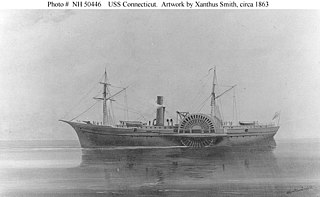
USS Connecticut was a large steamer acquired by the Union Navy during the American Civil War. Her primary task was to prevent ships from penetrating the Union blockade of Southern ports.

USS Octorara was a steamer acquired by the Union Navy during the American Civil War. She was used by the Navy to patrol navigable waterways of the Confederacy to prevent the Confederates from trading with other countries.

USS Calhoun was a captured Confederate steamer and blockade runner acquired by the Union Navy from the prize court during the American Civil War.
The order of battle for the Union and Confederate forces at the Battle of Mobile Bay on August 5, 1864.

During the American Civil War, blockade runners were used to get supplies through the Union blockade of the Confederate States of America that extended some 3,500 miles (5,600 km) along the Atlantic and Gulf of Mexico coastlines and the lower Mississippi River. The Confederacy had little industrial capability and could not indigenously produce the quantity of arms and other supplies needed to fight against the Union. To meet this need, numerous blockade runners were constructed in the British Isles and were used to import the guns, ordnance and other supplies that the Confederacy desperately needed, in exchange for cotton that the British textile industry needed greatly. To penetrate the blockade, these relatively lightweight shallow draft ships, mostly built in British shipyards and specially designed for speed, but not suited for transporting large quantities of cotton, had to cruise undetected, usually at night, through the Union blockade. The typical blockade runners were privately owned vessels often operating with a letter of marque issued by the Confederate government. If spotted, the blockade runners would attempt to outmaneuver or simply outrun any Union Navy warships on blockade patrol, often successfully.
The Texas Marine Department (1861–1865) was formed in the State of Texas shortly after Texas came under blockade from the Union Navy in 1861. It operated under the control of the Confederate Army during the Civil War.

John Cummings Howell was an officer in the United States Navy during the American Civil War. He rose to the rank of rear admiral and late in his career was commander-in-chief of the North Atlantic Squadron and then of the European Squadron.

William Edgar Le Roy was an officer in the United States Navy who served in the Mexican War, on the African Slave Trade Patrol, and in the American Civil War. He rose to the rank of rear admiral and late in his career was consecutively commander-in-chief of the South Atlantic Squadron, the North Atlantic Squadron, and the European Squadron.

The Huntsville-class ironclads consisted of two casemate ironclads ordered by the Confederate States Navy in 1862 to defend Mobile, Alabama, during the American Civil War. Completed the following year, they used propulsion machinery taken from steamboats, and were intended to be armored with 4 inches (102 mm) of wrought iron and armed with four cannons. Both CSS Tuscaloosa and her sister ship CSS Huntsville were found to be too slow for practical use, and were relegated to service as floating batteries. Union forces captured Mobile in April 1865, and the sisters were scuttled on April 12, as they were unable to escape due to an inability to steam against the current on the Spanish River.
